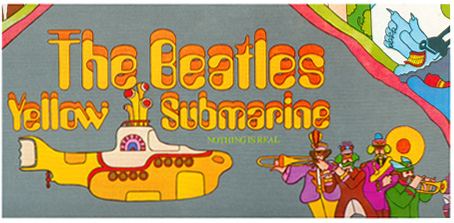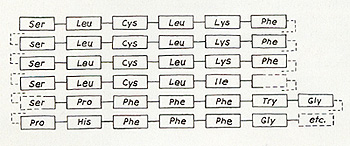|
Immortal Coding Sequences (Ohno, 1984; Ohno and Epplen, 1983)  A few genes is all that retrovirusess possess in their genome;
inherent replication error rate of reverse transcriptase is in the
order of 10 high-3/base pair/year (Gojobori and Yokoyama, 1985).
For bacteria it is about 10 high-4/base pair/year. In contrast,
the number of gene loci in the mammalian genome approaches 10 high
5; inherent replication error rate amounts to about 10 high-9 base
pair/year (Ohno, 1985). Thus, when it comes to DNA replication,
mammalia utilize a rather refined copying and editing machinery,
to keep all genes functional, whereas the genome of retroviruses
can afford to be enterprising. Non-enzymatic nucleic acid replication
can be expected to have a replication error rate not less than the
error rate of reverse transcriptase. This implies that an assigned
polypeptide chain experiences a lOO percent amino acid sequence
change every 1,000 years, a rather cumbersome situation for life
to emerge.  In the town where I was born lived a man who sailed to sea. And he fold us of his life In the land of submarines. So we sailed up to the sun fill we round the sea of green, and we lived beneath the waves in our yellow submarine. We all live in a Yellow submarine, yellow submarine, yellow submarine. We all live in a yellow submarine, yellow submarine, yellow submarine. And our friends are all on hoard; many more of them live next door, and the band begins to play. We all live in a yellow submarine, yellow submarine, yellow submarine. We all live in a yellow submarine, yellow submarine, yellow submarine. As we live a life of ease, everyone of us has all we need. Sky of blue and sea of green in our yellow submarine. 
Premature chain shifts are the most coding sequences may sustain.
They may come about by base substitution that changes an amino acid
specifying codon to a chain terminator. Furthermore, deletions and
insertions of bases that are not multiples of three in numbers displace
the reading frame. Resulting unusual reading frames tend to be full
of chain terminators and a shortening of chain lengths results,
which may deprive the polypeptide of its assigned function. However,
should the number of bases in a hypothetical abiotic oligomer not
be a multiple of three, coding sequences that arise by means of
oligomeric repeats are quasi "immune" to the above described base
change dilemma as shown for a heptameric repeat: The 21-base long
sequence (3 x 7) becomes the unit periodicity and encodes the heptapeptidic
periodical polypeptide chain. Abase change, for instance from a
cystein codon TGC to a terminator TGA, can silence only one of the
open reading frames, and readingframe shifts are of no consequence
because the periodicity of polypeptide chains is maintained. Hence,
a good measure of immortality is ingrained in coding sequences that
are repeats of N = 3 n+- 1 or 2 base oligomers. Such types of oligomeric
repeats have the further advantage of giving longer periodicities
to the polypeptide chains they encode. In evolution, new genes come
into existence from redundant copies of pre-existing genes. For
instance, the adaptive immune system of vertebrates has apparently
evolved by plagiarizing one ancestral gene (Mostow et al., 1984).
De novo recruitments of truly new coding sequences from the non-coding
base sequences have shown themselves to be near-exact repeats, thus
encoding polypeptide chains of the exact periodicity.  A few months ago I had the good fortune to listen to a talk by Susumu Ohno in which he was ablc to demonstrate that the repetitious recurrence manifested in the coding sequences in the genome pervades many aspects of human endeavor as seen, for instance, in music and architecture. During his presentation, coding base sequences became readily transformed into musical scores through the assignment of two consecutive positions each in the octave scale to four bases in the ascending order A, G, Tand C. Chopin's Nocturne, Op. 55, No.1, he transcribed to its base sequence. Three times the base nonamer CAACCTCCC recurred. Interestingly, the primordial building block base oligomer of the last exon of the largest subunit of mouse RNA polymerase II is the nonamer CAACCTCTC, which recurs four times. This is nothing more than a single base derived from the principal subject of Chopin's Nocturne and thus homology is established between the two. Transforming the first 106 codons of this "Last Exon" into a musical score for the piano, according to the modus operandi of Chopin's Nocturne, gave a fascinating concert piece. Indeed, listening to a tape of "Mouse's Last Exon" made you think of a Chopin composition even though not necessarily the Nocturne, as Susumu Ohno pointed out. "Mouses's Last Exon" has a lively dance cadence which is quite fitting for a RNA polymerase and which definitely is not a nocturnal creature, having instead to engage in transcriptional activity day and night (S. Ohno and M. Ohno, 1986). After the talk I wondered how the transcribed base sequence of an old Beatle song, "The Yellow Submarine", might look because "the sea of green" should certainly be an antique element (Fig. 11.32). |